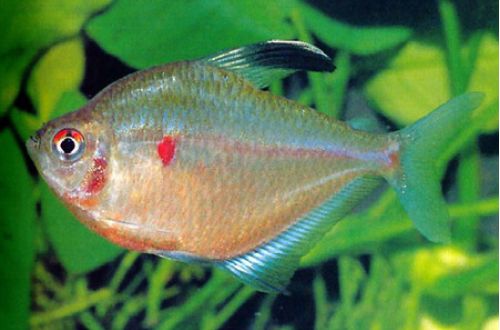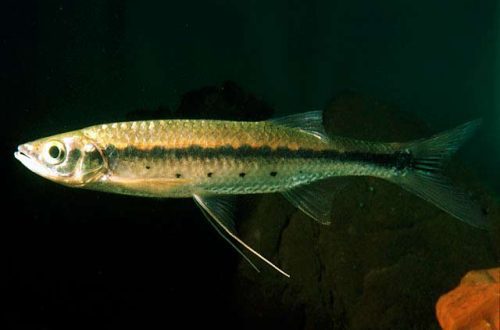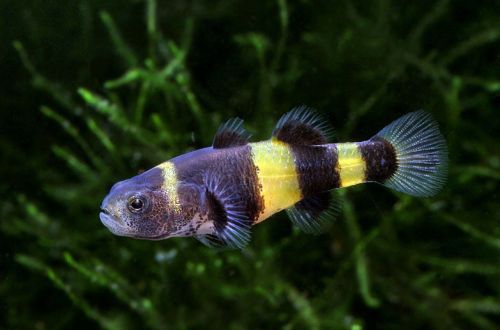
Chalceus red-tailed
Red-tailed chalceus, scientific name Chalceus macrolepidotus, belongs to the Characidae family. A rather large carnivorous species, it is not a real predator, but on occasion it can bite into a smaller fish. It is advisable to keep it in a separate aquarium and consider it more like a pet, which is not bright in color, but attracts with its behavior, especially during feeding. It is quite possible to invite friends to look at this spectacle.
Contents
Habitat
It is widely distributed throughout the northern part of South America on the territory of the modern states of Colombia, Venezuela, Guyana, Suriname, French Guiana and Peru. It lives in numerous rivers and their channels flowing in the rainforest canopy. Prefers to stay close to the surface.
Brief information:
- The volume of the aquarium – from 250 liters.
- Temperature – 23-28°C
- Value pH — 6.0–7.5
- Water hardness – soft to medium hard (5-18 dGH)
- Substrate type – sandy
- Lighting – moderate
- Brackish water – no
- Water movement – weak or moderate current
- The size of the fish is up to 25 cm.
- Meals – fresh or frozen meat products
- Temperament – active, conditionally peaceful, carnivorous species
- Keeping alone, or in a group of 6 individuals, but not less
- Life expectancy – up to 20 years
Description
Adult individuals reach a length of up to 25 cm, have an elongated body somewhat compressed from the sides. The caudal fin is large and deeply forked, painted red. The fins are often transparent, although in favorable conditions they also show a red tint. Otherwise, the fish does not differ in richness of colors, the dominant color is dull silver. Sexual dimorphism is weakly expressed – males are indistinguishable from females.
The red-tailed chalceus is very similar in appearance to its closest relative, the yellow-fin chalceus, but differs in larger size and, as the name implies, in the color of the fins.
Food
Carnivorous species, in nature hunts various insects and crustaceans. At home, he will take shrimps, mussels, earthworms, and flying insects cut into pieces. It is allowed to serve some dry food (flakes, granules) as a source of essential trace elements, but this should be nothing more than an addition to the main diet. It is worth noting that fish feed exclusively near the surface and will ignore any food that has fallen to the bottom.
Maintenance and care, arrangement of the aquarium
A spacious aquarium from 250 liters and the presence of large areas with open water are, perhaps, the main requirements for Redfin Chalceus. The decoration usually uses a sandy substrate with some beech branches and floating plants. Although the choice of decor in this case is not so important and can be selected based on the needs of other fish living with it.
The diet and large size of adults means a lot of waste, so the filtration system should be the biggest expense in setting up an aquarium. Another important element is the lid, which is designed to prevent the fish from jumping out (they are prone to jumping while feeding) and getting hurt by any sharp edges or burns from the lights.
Optimal conditions are characterized by the presence of a weak or moderate current, an average level of illumination, a water temperature in the range of 23–28 ° C, a slightly acidic pH value with low or medium hardness.
Behavior and Compatibility
Complex intraspecific relationships make it possible to keep Halceus either in a single aquarium or in a group of at least 6 individuals. With a smaller number, skirmishes are inevitable, where the weaker fish will be doomed. It does not fit well with other species, although it can get along with large representatives of characins, cichlids and catfish, which are not inferior to it in size. Not compatible with small fish that will be considered food.
Breeding / breeding
Reliable information about successful cases of breeding in an amateur aquarium at home has not been recorded. All fish for sale are commercially bred or wild-caught.
Fish diseases
A balanced aquarium ecosystem with the right conditions is the best guarantee against disease. If signs of illness are found (unusual behavior, rashes on the body, etc.), first check the quality and parameters of the water and only then take it for treatment. Often it is enough to return the conditions of detention to optimal values in order to solve the problem.





